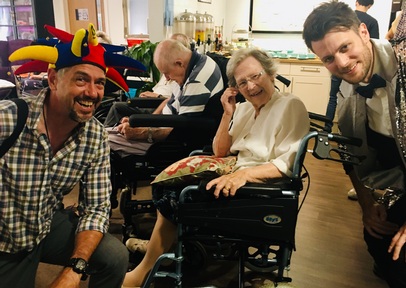Diversity, creativity and diplomacy: A day in the life of a speech and language therapist
Joanna Armstrong works as an independent speech and language therapist. She specialises in adults with communication disorders and swallowing difficulties (dysphagia) which have developed as a result of neurological conditions such as stroke, dementia, Parkinson’s Disease, Multiple Sclerosis, cortico-basal Degeneration, and brain injury.

Previously working in NHS hospitals, Mrs Armstrong now sees the majority of her clients in care homes or their own homes.
carehome.co.uk spoke to her about her experience and what she enjoys most about being a speech and language therapist.
What does a typical day look like for you?
I tend to see between two and four clients a day across a range of settings. I will plan all my sessions for the day first thing in the morning, developing activities that work towards goals set previously between the client and myself.
I see many clients in care homes for swallowing assessments. This typically involves liaising with the client’s family and key worker, usually a nurse or the care home manager, and I will look through the clients’ notes and medical history to ensure I have a thorough understanding of the background and swallowing/communication difficulties facing the client. I will then introduce myself to the client and explain why I am there and what I aim to achieve.
Once I have assessed the client and observed them eating and drinking, I will feed back my findings and recommendations to the client and the carers. I will ring the care home the next day for feedback on how the client is managing any changes to their diet or fluids and will schedule a follow-up visit to check how the client is managing.
There is also a lot of paperwork involved in being a speech and language therapist at the end of the day.
What is the best thing about working as a speech and language therapist?
The diversity of the role and the people you interact with as a result. No two clients, situations, experiences or difficulties are the same – everyone’s experiences and requirements are unique to them.
It is very isolating to not be able to communicate what you want to say easily or to understand what people are trying to communicate to you and I love that my job can really improve a client’s relationships and quality of life.
What is the most challenging aspect of being a speech and language therapist?
Being witness to people dealing with what is often a huge life-changing event in their life. Whether a loved one has a sudden event such as stroke or a slower-progressing illness such as dementia, there is a huge sense of loss for everyone involved and many changing emotions and situations to deal with. This can be difficult emotionally for everyone involved, but it is extremely rewarding to be in a position to help by providing practical advice and facilitating communication.
What qualities do you think you need for the job?

A good speech and language therapist requires a range of different skills. Obviously, good communication skills are key! You need to build trust with clients and their families quickly as they are often in vulnerable positions and it is important to be able to motivate people at a time they may feel like giving up. You also need to be creative and to think on your feet.
Due to the nature of communication difficulties, the speech and language therapist is often the person that clients are able to open up to about their feelings and emotions so some counselling skills are essential. There can also be conflict between the different parties in a client’s life so diplomacy and negotiation skills are also useful.
It was recently revealed that Monty Python’s Terry Jones is has primary progressive aphasia (PPA) as a result of dementia, which appears to have raised more public awareness of the condition. What are your thoughts on this?
Any publicity that helps educate people on communication difficulties is always beneficial in helping tackle people’s fear and lack of knowledge around communicating with people who have difficulties. Our ability to speak and use language as we do is a key distinguishing factor that separates humans from most other animals. Our identities are intrinsically tied up with our ability to communicate effectively and socialise, and when we lose this ability, the impact on our sense of self and role in the community can be eroded massively.
I do not come across people with PPA often, but it can be particularly distressing as it often affects people under 65, at a time when they may still be working full-time and feeling in the prime of their life. Having such a high profile figure as Terry Jones reveal he has PPA will help those with the diagnosis, not least of all in educating their friends and family about the nature of the illness.
What is your experience with dysphagia, particularly in clients with dementia?
While working in hospitals, the majority of my caseload was clients with dysphagia so I have plenty of experience in this field. There are often contradictory approaches taken to people with dysphagia due to dementia, and swallowing difficulties often increase at a time when that person is no longer able to communicate their wishes about how they would like to be managed.

We work closely with dietitians and medical teams to provide the best nutrition and hydration possible for that client. There can come a point when a person with dementia loses the ability to swallow safely entirely and difficult decisions need to be made over whether that person should be artificially fed and hydrated, either through a naso-gastric tube in the short-term or a PEG-tube in the long term. This is a hugely individual, sensitive and difficult decision and many things need to be considered, including the past and current wishes of the client, the person’s best interests, prognosis and quality of life.
It is vital that families are given the best possible information and are supported at this time by the medical team, therapists and carers.
What sort of a role do family members and care staff play in supporting the therapy you provide?
Family members and care staff are absolutely vital. Often family and carers may be the only contact a person has with ‘the outside world’ so it is key that they are able to maximise someone’s communication opportunities through advising friends and carers who come to visit on the nature of the person’s communication difficulties and passing on strategies and recommendations given by the speech and language therapist.
For more information about the therapy Joanna Armstrong provides visit: www.yourspeechtherapy.co.uk/
Latest Features News
 25-Nov-19
2019 Election: Boris Johnson leaves social care in 'too difficult box' but Labour vows to end 'crisis'
25-Nov-19
2019 Election: Boris Johnson leaves social care in 'too difficult box' but Labour vows to end 'crisis'
 18-Oct-19
Podcast: Wendy Mitchell and dementia: 'My biggest fear is not knowing who my daughters are'
18-Oct-19
Podcast: Wendy Mitchell and dementia: 'My biggest fear is not knowing who my daughters are'
 27-Sep-19
Exclusive: Care minister backs care workers' call for time off to grieve and attend funerals
27-Sep-19
Exclusive: Care minister backs care workers' call for time off to grieve and attend funerals
 19-Sep-19
Podcast: Gyles Brandreth says poetry helps ward off dementia
19-Sep-19
Podcast: Gyles Brandreth says poetry helps ward off dementia
 30-Aug-19
Edinburgh Fringe funnyman joins comics facing toughest audience at care home gig
30-Aug-19
Edinburgh Fringe funnyman joins comics facing toughest audience at care home gig